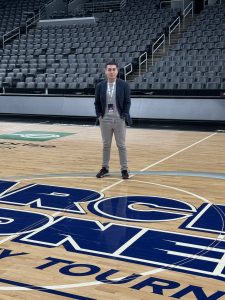In its third installment of four phases, NASA’s 3-D Printed Habitat Competition will once again be hosted by Bradley University. Bradley previously held phase two of the competition in August of this year and received confirmation of phase three earlier this month on Nov. 7.
As an international event, the 3-D Printed Habitat Competition draws in contestants from around the globe who compete to design an innovative habitat suitable for an environment on Mars.
Specific to the third phase, teams will focus on designing a sub-scale model of the habitat to be constructed on a set of strict limitations, for an opportunity to win a final prize of $2 million, associate professor Yasser Khodair said.
“The word ‘autonomous’ is specific to this phase of the competition,” Khodair said. “[The 3-D printer must] do things without human interaction. [They will] use recycled materials of what is indigenous to Mars and [will create] a habitat that must withstand hydrostatic testing, atmospheric pressure, electricity and plumbing. Phase three will be a sub-scale model of the shelter and [will be a step towards] the actual 93-meters-squared sized habitat.”
According to Lex Akers, dean of Caterpillar College of Engineering and Technology, the possible outcomes of the contest go beyond the hypothetical end goal of a Mars habitat – it may lead to innovation in construction on Earth.
“It is not a direct goal of the contest, but … an obvious extension [is] to be able to put up shelters literally within days after damaged houses from [natural catastrophes] or build habitats in very impoverished countries which are much safer and far better than what they typically use,” Akers said. “This technology could be just literally transformational in how we design homes and buildings here on Earth.”
With the opportunity to build relationships with companies such as NASA or representative contestants from other universities such as Penn State, both Khodair and Akers said hosting the event is an out-of-this-world opportunity for Bradley engineering.
“I am phenomonally excited,” Akers said. “It is an honor to be a part of this event. Working with professionals from NASA … has opened up doors that normally we would never get a chance to walk through … It helps our students, it helps our faculty get engaged with working professionals; there are just all kinds of great spin-offs that come from this.”
According to Khodair, as a professor, he is excited to see the benefits arise from being a part of the event for both students and faculty, as well as potentially making a mark on history.
“This is a dream come true. This is something we can, in the future, say maybe 30, 40 years from now that this competition was the seed for being able to live on Mars,” Khodair said. “The 3-D Printing, the use of recycled materials and structural testing is all state-of-the-art. So, involving our students in something like this enhances their teaching experience. I’m doing research on using recycled materials and concrete, and being involved in this type of work [which uses these materials] helps with my research.”
The third phase will be held in the Caterpillar Edwards Demonstration and Learning Center from April 29 to May 4, 2019.




